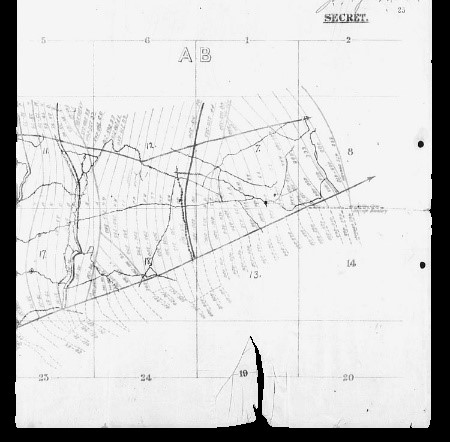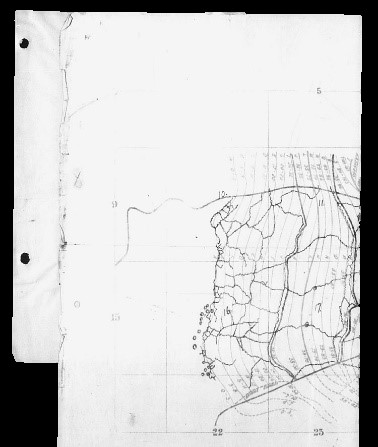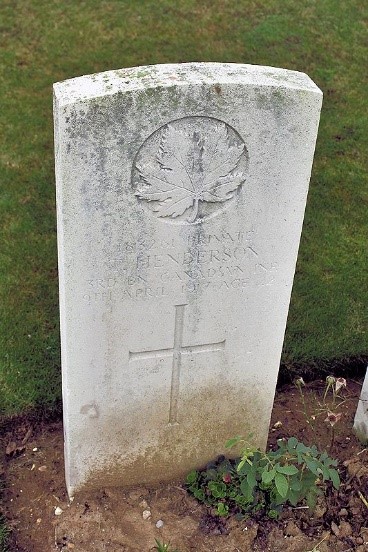In order to prepare for their upcoming journey to France to commemorate the 100th anniversary of the Battle of Vimy Ridge, students from across Canada research the life and death of a particular soldier in order to better understand and relate to the circumstances faced by so many young men and their families. Researching primary documents found online, the students provided brief biographies of these extraordinary men. Here is one such project:
Thomas Henderson, Private
1st Canadian Infantry Division, 1st Brigade,
3rd Battalion, “D” Company (Royal Regiment of Canada, Toronto)
By Breann S., Explorica traveller
Personal Information
Thomas Henderson was born on July 14, 1894. He is from Newark, Crocketford, Scotland and he is the son of Thomas and Jan Henderson. His father, Thomas Henderson was his next-of-kin. Thomas enlisted in the Canadian army on November 15th, 1915. He was 21 years old at the time. Thomas was 5 feet 10 inches tall and weighed 165 pounds. He had blue eyes with brown hair and had a fair complexion. Before Thomas enlisted he was a clerk in Newark, Crocketford. He had no military experience with the local militia. His religion was Presbyterian and was single.
Medical Records
When Thomas was examined for his medical health, his lungs had an expansion of three inches; this means he had very strong lungs. On June 10th, 1916, Thomas was admitted to Moore Barracks hospital to be treated for German measles and was in the hospital for 16 days. After being discharged from Moore Barracks hospital on June 26th, 1916. He rejoined the 3rd Battalion and was then killed at Vimy Ridge on April 9th, 1917.
The Final Days
On April 9th the Battle of Vimy Ridge began. The 1st Canadian Division would attack on the right of the Canadian Crops with the help of the 51st Division and 17th corps on its right and the 2nd Canadian Division on its left.
 The objective of the Battle of Vimy Ridge was across these two pictures. The first objective was to get to the Black Line which is where the map starts to the left. The second was the Red Line which is the first line going vertical. Third, the Blue Line is the second line going vertical. The final objective was going to the last line going vertical which is also known as the Brown Line. A second part of being at the Brown Line was also the capture of the guns in Farbub Wood.
The objective of the Battle of Vimy Ridge was across these two pictures. The first objective was to get to the Black Line which is where the map starts to the left. The second was the Red Line which is the first line going vertical. Third, the Blue Line is the second line going vertical. The final objective was going to the last line going vertical which is also known as the Brown Line. A second part of being at the Brown Line was also the capture of the guns in Farbub Wood.
According to the 3rd Battalion War Diary, the attack was to have the 2nd Canadian Infantry Brigade on the right and the 3rd Canadian Infantry of the left. The final objection was to reach the Red Line.
The 1st Canadian Infantry Brigade would attack between and through the 2nd and 3rd Canadian Infantry Brigades to the assault of the Swischen Stellung then to the Blue and Brown Line.
At Zero hour the 1st Canadian Battalion moved forward from their assembly area into their artillery formation behind the attack of the 2nd Canadian Infantry Brigade. At Zero hour plus 12 minutes, the 3rd and 4th Canadian Battalions would move forward from their assembly area and be in their artillery formation. The 2nd Canadian Battalion would follow the back of the 4th Canadian Battalion with a distance of 500 yards.
On April 9th at 8:55 a.m. enemy barrage was heavy on the old front line. At 9:33 a.m. all the companies, A, B, C, and D were all intact and 120 yards in the rear of the Red Line Objective. At 10:55 a.m. a message was received from Captain McCormick that the Blue Objective was taken. The Blue Objective was taken by the 4th Battalion. At 11:30 a.m. the artillery fire on the Blue Objective was very heavy. According to the 3rd Battalion War Diary, at 2:27 p.m., Major Reid from “D” Company reported that he pushed his patrols into Farbus Wood. However, the 4th Gordons did not meet him so he instructed “B” Company to form a defensive flank along the Sunken Road going South East from Commandants’ House. He also reported that there was progress in digging the Main Line of Resistance. At 4:20 p.m. 3rd Battalion firmly established themselves in the wood, capturing a battery of enemy guns and 35 of the personnel, including three officers. At 6:50 p.m. Major Reid reports that the Gordons were nowhere to be seen on their right flank and that this was very serious because their left flank was in the air. The final objective which was the Brown Line was reached on April 9th, 1917.
Military Movements
Thomas Henderson enlisted on November 15, 1915, in Calgary, Alberta with the 89th Battalion. He was then put into Company D and was taken on strength into the 3rd Battalion on October 21, 1916. He stayed in the 3rd Battalion until his death in combat at Vimy Ridge on April 9, 1917.
Thomas left Halifax, Nova Scotia and sailed on the SS Olympic on May 31, 1916, and arrived in England on the 8th of June. He trained with the 89th Battalion. During his time in the 89th Battalion, he was admitted to Moore Barracks hospital on June 10 and was released on June 26. On August 13th, 1916, Thomas was put into the “D” Company and then two months later on October 21st, 1916 he was moved to the 3rd Battalion where he stayed until he was killed in action.
On the 9th of April of 1917, the 3rd Battalion had a very traumatic battle at the Battle of Vimy Ridge. There is not much military movement recorded for “D” Company, but the information that was recorded, “D” Company had some very traumatizing combat. At 8:55 in the morning the enemy barrage was very heavy on the old front line. A half hour later at 9:33 all the companies were all intact and 120 yards from the Red Line Objective.
 When 2:27 p.m. came, there was a report from the “D” Company major, Major Reid pushed his patrols into Farbus Wood, but had to instruct “B” Company to form a defensive flank, because the 4th Gordons were not able to meet “D” Company. This defensive flank ran along the Sunken Road traveling South East from Commandants’ House. Major Reid also reported that the digging of the Main Line of Resistance was in progress. According to the 3rd Battalion War Diary, at 4:20 p.m., the 3rd Battalion finally settled into the woods. They also captured a battery of enemy guns as well as 35 personnel. Out of the 35 personnel, three of them were officers. Finally at 6:20 p.m. Major Reid reported that the Gordons were missing on Major Reid’s right flank. This became a problem because the left flank was vulnerable.
When 2:27 p.m. came, there was a report from the “D” Company major, Major Reid pushed his patrols into Farbus Wood, but had to instruct “B” Company to form a defensive flank, because the 4th Gordons were not able to meet “D” Company. This defensive flank ran along the Sunken Road traveling South East from Commandants’ House. Major Reid also reported that the digging of the Main Line of Resistance was in progress. According to the 3rd Battalion War Diary, at 4:20 p.m., the 3rd Battalion finally settled into the woods. They also captured a battery of enemy guns as well as 35 personnel. Out of the 35 personnel, three of them were officers. Finally at 6:20 p.m. Major Reid reported that the Gordons were missing on Major Reid’s right flank. This became a problem because the left flank was vulnerable.
Lest We Forget
Private Thomas Henderson’s file does not say when he finished his will, but he left everything to his father, Thomas Henderson who lived in Newark, Crocketford, Scotland. Thomas is buried in the Bois-Carre British Cemetery in Pas de Calais, France. The Bois-Carre British Cemetery is about half a mile east of the village Thelus, on the south side of the D49 road to Bailleul-sire-Berthoult. Thelus is 7 kilometers north of Arras. Thomas’ grave plot is II. E. 1.
Thomas Henderson, was a man who gave up his life to serve is country. He enlisted because so many other young men were giving up their life to serve their country. Thomas is no war hero, but he should still be remembered as a Canadian soldier who gave his life up for the freedom of Canada.
